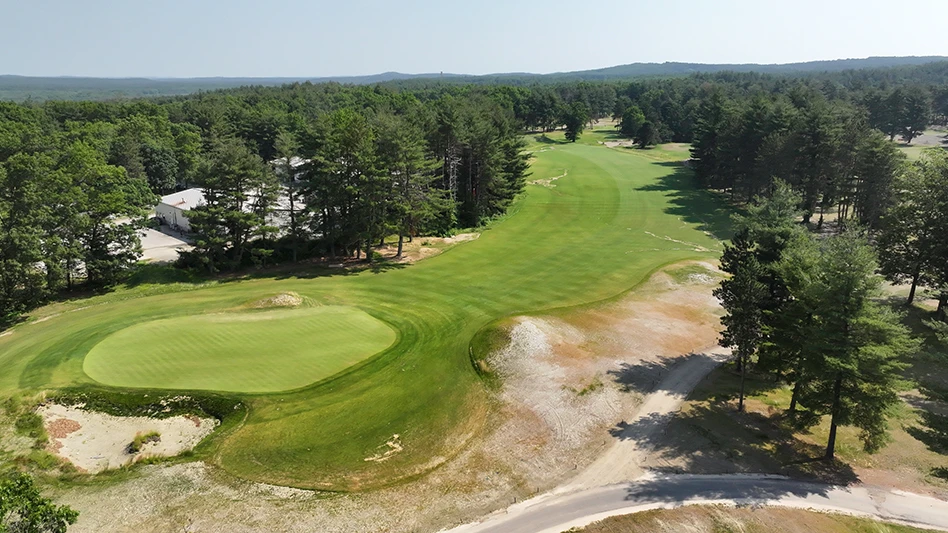
Courtesy of The International Golf Club
With the hopes of making better use of the course's unique topography, The International Golf Club’s Pines course is completing a full-course renovation with the implementation of fescue on its fairways.
The project began at the club in suburban Boston in 2022, as architects Bill Coore and Ben Crenshaw made the decision to grow and replace the fairways with fescue grass – a cool-season turfgrass. Maintaining a golf course with fescue is not a common task in New England.
The Pines, one of The International’s two courses, was opened for play in 1955. The Geoffrey Cornish-designed course was named the longest golf course in the world at 8,040 yards. The property was purchased by International Telephone & Telegraph in 1961, and the course served as a retreat space and private club.
In 1967, ITT renamed the course The International Club and in 1972, Robert Trent Jones completed a renovation softening the bunkers and greens and lengthening the course to 8,325 yards. The club was purchased by Escalante Golf in February 2021.
The decision to use fescue on fairways came from consultation from the entire team – designers, the superintendent, ownership, environmental consultants and the golf construction contractor.
“We needed to build a consensus and make sure everyone was on board as we would never want to dictate such a large decision,” Coore & Crenshaw associate Ryan Farrow says.
New York’s East Hampton Golf Club and Massachusetts's Old Sandwich Golf Club, both Coore & Crenshaw-designed courses, feature fescue fairways, and The International director of agronomy Michael Galvin has relied heavily on their experiences as well as other turf experts to help maintain the project. Dr. R.H. Hurley, Dr. Leah Brilman of Seed Research of Oregon and experts from Syngenta assisted in the formula decisions.
“Not being afraid to kind of reach out there to get some of the industry leaders to get their whole insight,” Galvin says. “Obviously, fescue is new to me. So just really leaning on some of some of the industry leaders throughout the process.”
After consultation from industry professionals and Brilman, the course chose to use a fescue blend consisting of creeping red fescue and chewings fescue.
During the decision-making process, the team debated between fescue and bentgrass. Fescue has low nutrient requirements and thrives on less fertile soils. This means a lower need for fertilization and minimal watering. The grass will help decrease the course’s water budget, and lower its mowing frequency, Galvin says.
“The fine fescue certainly has a slower growth rate than bentgrass,” Galvin adds. “And, how adaptive it is in varying conditions from full sun to deep shade, it makes it versatile for The Pines.”

Through using fescue, the course was able to design greens surrounded by short grass, allowing for a more links-like experience, Farrow says. Fescue also provides the opportunity to change mowing lines.
“We like to start out trying to mow almost everything at fairway cut during grow-in,” Farrow says. “After the grass is established and we get a chance to look at each hole, we will get back out there and start to bring the mowing lines in and shrink the amount of maintained fairway.
“The process can also work in reverse, for example, if a fairway section becomes too difficult to mow, then you simply stop mowing it and allow the wispy grasses to mature, this is also helpful if you get a spot of the course where shots are bouncing out of play or just rolling too far away from an elevated green, in that case we can simply let the grass grow up and that will help slow the ball down and hopefully keep it in play.”
As the project was introduced to make better use of the course’s topography, Farrow says the “firmness and slick playing conditions” the fescue grass provides will lead to more interesting shot options.
“We also like to leave openings to access our greens from the ground, having fescue allows for a more consistent and predictable firm bounce so we can provide different playing options to get to certain pin positions of the green by landing the ball short,” he adds. “We think golf is more fun on the ground, watching the ball roll is one of the more thrilling experiences you can have on the course.”
Galvin says the project is close to being complete, but not quite there yet. Eight bunkers need to be completed, cart paths need to be finished and cart path tie in’s need installed. After opening, adjustments may still need to be made.
“Once we start to see some play,” Farrow says, “we will need to watch where tee shots or approach shots that land short of the green collect, if the height of cut is too low, we could see hot spots with too many divots in a concentrated area.”
Kelsie Horner is a Kent State senior majoring in journalism and Golf Course Industry’s summer editorial assistant.
Latest from Golf Course Industry
- From the publisher’s pen: Conscientious of a bigger role
- Bernhard and Company partners with Laguna Golf Phuket
- Terre Blanche showcases environmental stewardship
- VIDEO: Introducing our December issue
- Bernhard and Company introduces Soil Scout
- Nu-Pipe donates to GCSAA Foundation’s Centennial Campaign
- GCSAA enhances golf course BMP tool
- Melrose leadership programs sending 18 to 2026 GCSAA Conference and Trade Show





